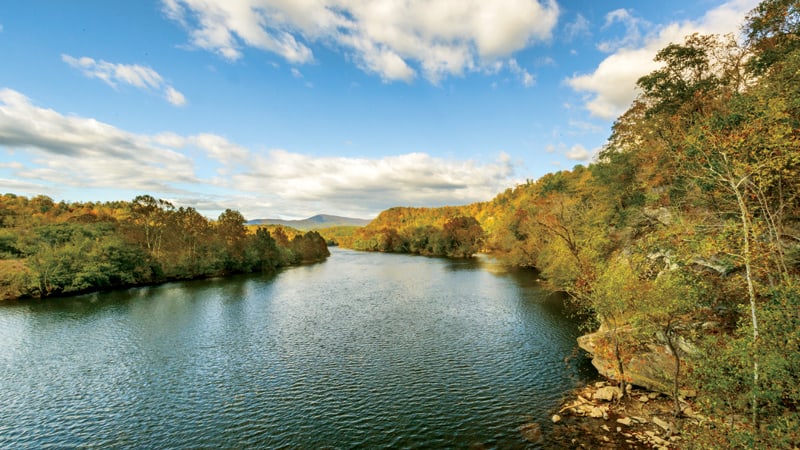America's River: The James River
History, natural beauty and conservationism tell the story of the James River

The sun has yet to rise over the Blue Ridge Mountains, and upper James River community conservationist Rob Campbell is investigating a potential violation. It’s September 2017, and there have been complaints that the Reusens Dam hydroelectric power plant, two miles upstream from Lynchburg, is holding back too much water, thereby reducing flow downstream and damaging overstressed ecosystems.
The problems started earlier that summer, but when Campbell approached Eagle Creek Renewable Energy officials, he says they denied any wrongdoing.
“Residents say there are times when the flow stops almost entirely,” says Campbell. However, due to a second dam downstream, U.S. Geological Survey gauges remain unaffected. “I need photographs that confirm willful neglect. Then I can bring in federal authorities.”
Just below the dam, Campbell turns his truck onto Hydro Street and parks. Exiting the vehicle, he slips through a stand of trees and scrambles down the riverbank. There is the familiar crash of water – night-vision binoculars reveal nothing amiss.
“I’ve been out here so much, I think they’ve started posting sentries,” he says. “They’re opening the gates before I can get in range for a shot.”
Soon thereafter, Campbell obtained the evidence he needed using a drone. The Federal Energy Regulatory Commission opened an investigation into the dam’s operations this past January.
“My job stands at the intersection of opposing interests that have a very different understanding of the word ‘resource,’” says Campbell. Many companies, including some farmers, view the James in terms of how it can best aid their quest for profit. Conservationists strive to preserve and protect its natural beauty.
“Of course, I’d rather spend my days enjoying the river’s scenery and teaching kids about its amazing historical legacy,” says Campbell. “However, what that legacy look like for future generations depends on how rigorous we are about protecting the river right now.”
Ultimately, the story of the James River is a collision of industry, nation-building, environmental cleanup and raw natural beauty.
SAFEGUARDING THE JAMES
Employed by the James River Association, Campbell patrols around 240 miles of river and works with state and federal environmental organizations to serve as its “eyes, ears and voice.” This puts him on the river nearly every day. He coordinates tree plantings to fight erosion, works with farmers to keep cows out of the water, helps with educational outreach, monitors potential polluters and much more.
Like many, Campbell’s relationship with the James began with an enthusiasm for canoeing and kayaking. By his late teens, the Amherst native had paddled from the river’s headwaters to Richmond and had worked as a professional guide. Yet, it was history that led him to a career in conservationism.
Attending the yearly Virginia Canals & Navigations Society Batteau Festival, he discovered the James was “the most historically significant river in the country.” In 2007, a congressional resolution named it “America’s Founding River,” due to its “extraordinary historic, economic, recreational, and environmental importance.”
“Up to then, I hadn’t truly realized the James River’s value as a resource,” says Campbell, who joined the JRA in 2013. “That’s when I decided to dedicate myself to the preservation and protection of this river.”
HEADWATERS OF CURIOSITY
As the founder and director of the VCNS, Bill Trout, 80, understands Campbell’s passion. He’s been hooked on the James since the age of 10, when he spotted the stone remains of a canal lock on a Boy Scout field trip in downtown Richmond.
“I asked our guide what it was, but he was clueless,” recalls Trout. At home, his parents didn’t know either. Intrigued, he visited the library and discovered the structure was part of the ruins of the James River and Kanawha Canal – a project to develop a commercial trade route linking the James and Ohio rivers in the 1780s.
“Here was all this history, right in my backyard, and no one seemed to know much about it,” says Trout. “For me, that was very alluring. It became like a treasure hunt.”
It didn’t take long for him to learn the James played a pivotal role in shaping history before and after European colonization. Beginning in the Blue Ridge Mountains at the confluence of the Jackson and Cowpasture rivers near the small town of Iron Gate, it flows for 350 miles and empties into the Chesapeake Bay at Hampton Roads. Its watershed covers 6.5 million acres. Formed during the Mesozoic, the waterway connected to the Bay some 200 million years ago and has been passing through what’s now Richmond for about 2 million years. About 15,000 years ago, nomadic groups started hunting and fishing along its banks during seasonal migrations. As they settled into agrarian communities around 1,000 B.C., bountiful fish, wildlife, fertile soil and readymade transportation made the river a perfect site.
When the Virginia Company arrived in 1607, the settlers established the first permanent European colony on Jamestown Island, some 35 miles upriver from the Chesapeake Bay. Soon thereafter, Christopher Newport sailed upriver and discovered a thriving native capital at the site of modern-day Richmond. From there, chief Powhatan governed a powerful confederacy of 30 tribes, including upward of 21,000 people. The nation stretched to the Chesapeake Bay. Subsequently, on John Smith’s 1612 Map of Virginia, the James appears as the “Powhatan Flu.”
“Powhatan positioned his capital just below the fall zone for a very good reason,” says William A. Fox, author of The James River. The geological feature causes waters to fall more than 105 feet in just seven miles. Creating a nautical impasse of rocks and rapids, it marks the transition between the Piedmont and the coastal plain. “Boats traveling in either direction had to portage around the falls, so, he who controlled Richmond controlled trade.”
Similarly, the fall zone helped shape the colony’s expansion and eventually inspired the largest and most expensive engineering effort the world had ever seen – of which the canal lock glimpsed by young Trout was but the tip of the iceberg.

AS THE JAMES FLOWS, SO GOES VIRGINIA
It started in 1612, with John Rolfe proving he could grow commercial quantities of Spanish tobacco in Virginia. When further experimentation revealed the terroir produced a superior product – the fertile James River bottomlands nurtured darker leaves with a sweet, surprisingly mild flavor – it sparked an economic boom and spitfire expansion.
“The Spanish had a monopoly on the European tobacco trade, which the English hated,” says Leonard Smith, a historian with the Virginia Tobacco Farm Life Museum. “Rolfe’s discovery offered a means of independent production and was quickly nationalized.”
The groundwork was laid for a tobacco-based economy.
As agricultural prospectors flocked to Virginia, plantations were installed farther and farther inland. Because Jamestown was the only major port for exportation, they built along the James. The pattern led to the establishment of Richmond in 1733, then Lynchburg in 1757.
By the Revolutionary War – which was funded in part by Virginia tobacco profits – the colony was exporting 50 million pounds of tobacco a year, and the bulk of it traveled the James. Lynchburg, Richmond and other cities and towns along the James had become critical trade hubs and centers of concentrated wealth.
The trend continued after the Revolution, with Virginia’s growth being heavily influenced by the James until the advent of the railroad about the time of the Civil War.
“Lynchburg was known as Tobacco City and served as a crucial point of distribution for settlements in the Shenandoah and Roanoke valleys and points beyond,” says Trout. Coal, furs, minerals, wheat, cotton and other resources passed through as well. In Richmond, the fall zone provided river-power to drive flour mills and factories for iron production.
With so much river commerce, canal systems were installed to ease navigation and allow passage around the falls. George Washington and John Marshall, the first U.S. president and fourth chief justice of the Supreme Court respectively, were major stakeholders in the James River and Kanawha Canal Company.
By the Civil War, a fleet of more than 200 shipping vessels utilized the canals, transporting goods from the Allegheny Mountains to Richmond. Below the capital, steamships carried materials and passengers.
Although Richmond was an economic powerhouse, its prosperity had a dark side.
“Before the passage of the 13th Amendment in 1865, upward of 500,000 African-Americans were sold into slavery at Richmond markets,” says Fox. “This made the city the nation’s second largest center of slave trade, second only to New Orleans.”
SHIFTING SANDS
Opened in 1837, Richmond’s Tredegar Iron Works became one of the largest foundries in the nation and the largest in the South. On Belle Isle, iron works were established in 1814, which, after being incorporated into the Old Dominion Iron and Nail Company in 1858, became the largest manufacturer of nails in the country. With proximity to coal fields and railroad transportation, both thrived for more than a century.
In the decades following the Civil War, railways were laid over canal towpaths. The shift toward railroad shipping furthered industrial development along the James.
During the industrial revolution of the 1880s, demand for coal surged. As coal mining expanded into southwest Virginia, railroads began shipping huge quantities of Virginia-mined coal to the coast for export. Shipyards expanded rapidly.
PROTECTING THE WATER
As iron production was surpassed by steel in the 20th century, industry on the James shifted toward chemical manufacturing, paper milling, electricity generation and other processes that benefited from a virtually unlimited supply of water. Combined with the fact that most cities dumped sewage directly into the river, pollution was rampant.
“In 1913, the Virginia House of Delegates debated regulating pollution on the river,” says DEQ environmental specialist Keith Boisvert. “However, a representative summed up the majority opinion by saying, ‘Rivers are our God-given sewers.’”
Real, enforceable regulation did not begin until the federal Clean Water Act was approved in 1972. In Virginia, the legislation led to the creation of four agencies to monitor and regulate the environment. In 1993, the agencies were consolidated to form the DEQ.
“In the ’70s, the James was largely unfit for fishing and swimming, mostly due to industrial pollution,” says Boisvert. In 1975, high levels of Kepone, an insecticide, were discovered below Richmond. Hopewell’s Allied Signal Company had essentially been dumping the neurotoxin into the river since the early ’60s. “The contamination was severe and led to a 13-year fishing ban from Richmond to the Bay,” he says. “It won the James the distinction of being one of the most polluted rivers in the country.”
However, there was a silver lining. The shock catalyzed environmental reform and led to mass cleanup efforts. Looking to create a watchdog organization, a group of concerned citizens and environmentalists formed the James River Association in 1976.
“The Kepone episode showed the public we needed regulation,” says Campbell. Ultimately, it led to a crackdown on point-source polluters and served as a clarion call for conservationists. “The JRA’s founders wanted to … help steer conservation efforts in a direction that would most benefit the river.” They hoped to document environmental hazards before they became a threat and thus prevent another disaster.
A NATURAL AFFINITY
Today, much of the James is viewed less in terms of industry, more as an emblem of outdoor recreation and natural beauty. By 2012, the image was so well established that Richmond was named the “Best River Town Ever” by Outside magazine.
“As the river got healthier, people started getting back out on the water,” says Ralph White, former director of Richmond’s James River Park System. Over the course of his 32-year career, White saw park visits rise to more than 750,000 a year – “three times our rates in the early ’80s.”
The trend was felt throughout the watershed and has led to the formation of numerous riverside parks and trails. Seeking to link them all together in a single network, the Virginia Department of Conservation and Recreation is developing the James River Heritage Trail from the Allegheny Mountains to the Chesapeake Bay.
Helping the cause was the achievement of an unprecedented conservation landmark in 2015. That year, the JRA’s “State of the James” report gave the river an environmental score of “B-” – the highest it has ever received.
“That was huge, but if we want to preserve the James for our great-grandkids, we need to go further,” says Campbell. “We need to reduce nutrient runoff from farms, do a better job of managing storm water and update antiquated sewage treatment facilities.”
If that happens, Campbell believes the rating could rise to an ‘A’ within his lifetime. Virginia would then be the home of a historically significant and pristine river.
Eric J. Wallace is a career journalist and avid outdoorsman whose love affair with the James River began with childhood canoe trips – the first when he was just 6 months old. His writing has appeared in more than 40 magazines, including Backpacker, All About Beer, Canoe & Kayak and Modern Farmer. He is a contributing editor for Gastro Obscura.


